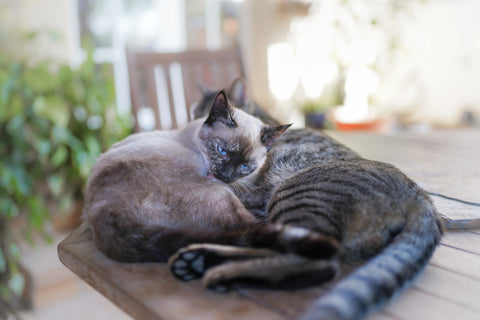
Headaches are possibly one of the most prevalent pain complaints in people. Because there are no available methods to detect an ongoing headache, we rely on the ability to communicate this pain to each other in order to diagnose it and relate it to other aspects of our health. Our pets, sadly, can't enjoy this luxury. For this reason, we often remain completely oblivious to the fact that cats can also get a headache! Here is what you need to know about cat headaches, how to recognize them, and what to do to help your cat.
What is a headache?
A headache is a term used to describe a symptom of pain in any of the regions of the head or neck. Headaches are broadly classified as primary and secondary. Primary headaches are "harmless" or "benign", and they are not caused by other health or structural problems. Most common primary headaches in people are:
1. Tension headaches: the most common type,
2. Migraines: recurrent moderate to severe headaches,
3. Cluster headaches: recurrent severe headaches often described as the most painful type of primary headache disorder;
Secondary headaches are caused by diseases or injuries, and they can be harmless or dangerous. The International Headache Society created The International Classification of Headache Disorders (3rd edition) (ICHD-3) for headache types in people.
Headaches in animals are generally understudied, and there are currently no official classification systems created for cats. Primary headaches can't be detected, which is why we can't directly pin-point them in cats. However, it is known that dogs and cats, do experience headaches, often in association of other diseases or health concerns.

Anatomy of a headache
Headaches are associated with pain in different regions of the head or neck. The brain itself brain is insensitive to pain, because it doesn't have pain receptors. This means that the pain associated with the headache will occur in other areas of the head that do have pain receptors. These are meninges (three membranes covering the surface of the brain), blood vessels (arteries and large veins), venous sinuses, cranial and spinal nerves, head and neck muscles, parts of eyes, ears, teeth and other head regions. The headache itself most commonly results from the traction or irritation of the meninges and blood vessels. Headaches can also be triggered by vasodilation, blood vessel spasms, inflammation or infection of the meninges, and muscular tension. The exact pathophysiology of cat headaches hasn't been described yet, while the exact mechanism in which a headache occurs has not been described in any species, including people.
Headache causes
Headaches in cats can be caused by many different factors, including head trauma, brain diseases (i.e. concussion, encephalitis, tumor), other diseases (i.e. upper respiratory infection), fever, dental problems, allergies, certain foods, dehydration, stress and other.

How to recognize if your cat has a headache
As mentioned above, determining a headache in a cat is very challenging. Aside from their inability to communicate their pain to us, cats also tend to hide their pain and any signs of illness. It is thought for this to be a survival instinct to avoid showing a weakness in front of a potential territorial rival. If your cat is experiencing a headache, you might notice some changes in their behavior, however. These include:
- Increased agitation (your cat might bite or scratch when being handled or if you touch a painful area),
- Changes in breathing (breaths are shallower and faster),
- Panting,
- Excessive purring,
- Changes in the eyes and vision,
- Changes in the heart rate and pulse,
- Decreased appetite,
- Lethargy and overall lack of energy and motivation,
- Fever,
- Unusual changes in the grooming behavior (your cat might either groom excessively due to stress, or neglect its fur),
- Changes in the litter box behavior;
What you can do
Considering how difficult it is to diagnose a cat headache, it subsequently remains challenging to treat it too. If you think your cat might be experiencing a headache, do consult with a veterinary professional who can diagnose this and find any potential underlying causes. If your cat's headache is secondary (caused by head trauma or other underlying problems), the headache will usually be aided after addressing the problems causing the pain. However, if your cat is expecting a primary headache, the treatment is more challenging because it is very difficult to pin-point the exact cause associated with it. You will most likely have to keep a diary of your cat's daily routine, lifestyle and diet in order to find factors that may be causing your cat pain. Your vet team will be able to assist you with this, and they will prescribe potential treatment for your cat.
Please do NOT prescribe a treatment for your cat without consulting with a veterinary professional first, and NEVER treat your cat's headache with human painkillers! If your cat seems to be in pain, ALWAYS consult with a veterinary professional ASAP.

Cats can't communicate their pain to us, and they are experts at hiding pain and discomfort. For this reason, we often completely miss out on symptoms of headaches in cats, and many of us are completely oblivious to the possibility that they even can experience this discomfort. Test your cat at home with Basepaws and on top of your cat's health!
Learn More
Further citations:
Headaches in Animals by dr. Ken Tudor on PetMD
Do Housecats Get Headaches? by Richard Parker at Senior Cat Wellness
Do dogs get headaches? by Daniel Kolitz at Gizmodo



